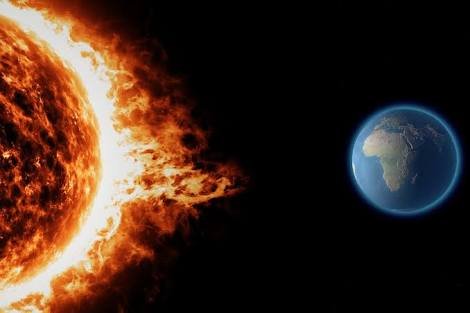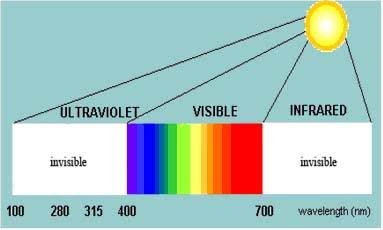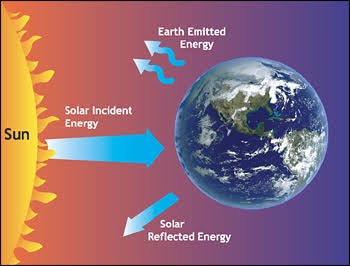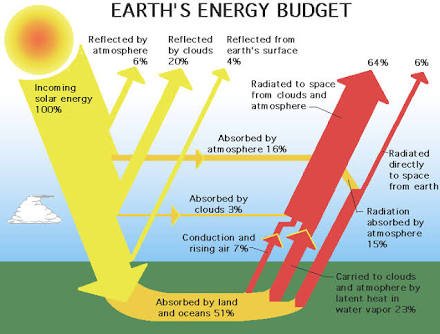Insolation of Solar Radiation That Shines On the Earth
Steemit's best friend, I'm back with my writing about science. Am I a very good man in conveying science? No, I just read and quote a few words to encapsulate it. My writing this time is about the sun. As you know, you can not believe if I said I've been researching about the Sun, so how do I know? That is by reading.
What do you know about the Sun? The Sun or the Solar System is the star in the center of the Solar System. The shape is almost round and consists of a hot plasma mixed with a magnetic field. The diameter of the sun is about 1,392,684 km, approximately 109 times the diameter of the Earth, and its mass (about 2 × 1030 kilograms, 330,000 times the mass of Earth) represents approximately 99.86% of the total mass of the Solar System.

In astronomical systems, the sun is the center of planetary circulation in the solar system, the source of energy and life, and controls the flow of weather, climate, air and sea, called heliocentris. The sun emits radiation rays with very wide wavelengths. Sun radiation is a form of electromagnetic wave energy, which consists of an electric field and a magnetic field, emitted by the sun that has a temperature above zero and is the only form of energy that can radiate in a vacuum.

Solar radiation into three kinds:
- Ultraviolet
- Infrared, and
- Visible light
In three types of solar radiation is also called the global radiation of the sun, solar radiation directly illuminates the surface of the earth and the radiation coming from the spread of the atmosphere. In general, solar radiation has energy every minute of 56 x 1026 calories, and this energy reaches the earth only 2.55 x 1018 calories only.
The radiation of the sun that comes or shines on the earth is called insolation, "the acceptance of solar energy by the surface of the earth in the form of short wavelength rays that penetrate the atmosphere layer.Insolation plays an important role in regulating and controlling the viability of the earth and depending on the time and place when receiving sun exposure . "

Three ways sun radiation reaches the Earth:
Direct Radiation
Solar radiation that enters the earth without any changes in direction, or radiation received by the Earth in parallel position at the time of irradiation.Spread Radiation
Solar radiation that changes due to the process of reflection and scattering of the sun.Total Radiation
Total amount of direct radiation and scattering radiation.
The intensity of solar radiation that illuminates the earth is also reduced so it does not become direct radiation. This is influenced by several reasons:
a. The Process of Reflection By the Earth's Atmosphere Layer
Absorption of substances in the atmosphere layer, mainly by O3, H2O, O2, and CO2 gas.
b. The existence of Rayleigh scattering Process
The existence of noodle scattering. So it can be said that the radiation of the sun that shines on the earth undergoes reflection, absorption, and transmission.
The radiation of sunlight coming into the earth can be known through long sunlight exposure, the duration of sunlight to the surface of the earth within a day, measured for hours. The one-day period is called the length of the day, or the sun's time is above the horizon. The daily duration of sunlight differs greatly from one month to another, within a year.

Usually the observation time of exposure to sunlight radiation is done at 08.00 am until 04.00 pm, every day. The process of solar radiation to the earth is influenced by several factors that affect solar radiation to the earth, affecting the determination of the amount and time of radiation of sunlight itself.
- Time and Position of the Earth's Location Against the Sun
The solar radiation based on time depends on the location of the latitude of the earth against sunlight and atmospheric conditions. While based on its position, sunlight depends on the position of the sun itself above the earth, is it above the equator? or far from the equatorial position on earth?
If the sun is positioned just above the equator then the intensity of solar radiation will be stronger, and vice versa, if it is far from the equator then its intensity will decrease. This leads to differences in climates and seasons in some regions of the Earth's surface. In addition, this causes a change of day and night on earth.
The Distance Between the Sun and the Earth
Earth's distance to the sun is about 1,495 x 1011 m with an angle of about 32 degrees. During the revolution process, the earth has a slope angle of about 23.5 degrees with its elliptical trajectory. This causes the turn of the season, day and night.Duration of Day and Angle Of Sun Radiation Coming
Today's duration is based on place differences based on latitude that cause the period of sunlight reception. While the angle of radiation is coming, sunlight determines the least amount of solar radiation that the Earth receives. The more horizontal surface area that gets the sun's radiation, the greater the angle of solar radiation, the greater the angle of solar radiation, the narrower the atmospheric layer passes through it.Effect of Earth's Atmosphere Layer
When solar radiation enters the atmosphere, solar radiation will be affected by some aerosol gas "formed from combustion processes, gas phase reactions, solid particle dispersion and chemical reactions, ocean dispersions, volcanic gases" and cloud conditions present in the layer. Thus, solar radiation is reflected back into space and there is more that is absorbed into the surface of the earth.
The type of solar radiation that enters the earth's surface can be a direct radiation and scattering. Furthermore, the role of the cloud itself also determines the short length of solar radiation to the earth per hour, and because the presence or absence of clouds will determine the duration of solar irradiance per day. Also read about the sun layer.
Well, that's what I can write about the sun, hopefully useful and thank you for reading. Thanks also for giving me the vote. Regards Steemit.

Note: All letters and numbers are mine, but the picture I got from google, I just use it to connect from my writing.

About The Science I Have Written:
Science: | Science: | Science: | Science: | Science: | Science: | Science: | Science: | Science: | Science: | Science: |
=======================================================================================
This post was upvoted by Steemgridcoin with the aim of promoting discussions surrounding Gridcoin and science.
This service is free. You can learn more on how to help here.
interesting stuff, you know anything about the solar 'storm'?
Thanks for commenting @cryptonce, that is a good question.
About the Solar Storm, I've read it in 2017, I read on the news issued by NASA. That at the time, NASA told the world that there would be a Solar Storm, but that did not happen.
About the Solar Storm. A Solar Storm is a particular activity of sunlight that releases high-energy particles. The phenomenon of solar storms formed by the turmoil in the solar atmosphere triggers the formation of black spots. This condition can cause a flame jump (solar flare) material that can be thrown to Earth. A solar storm is an event that takes place about eleven years from a low activity period, called Solar Minimum, until the period of activity increases, called Solar Maximum.
The solar storm is often accompanied by a bubble of plasma that reaches twice the earth. When touching the earth, solar storms can trigger disruption of communication, GPS and electricity. However, solar storms also have a tremendous impact. Particles that interact with the Earth's magnetic coating at the poles will produce auroras.
Earth has a magnetic shield so that hurricane hits are not fatal. Another case when humans are on the moon, humans will get solar radiation in large quantities that will be very dangerous.
thank you for the informative answer! time to wear sunscreen
Send 0.1 SBD to @gemsborg with the link to post you would like voted on as the memo! You will receive a upvote worth 2x the value. Please only send 0.1 SBD